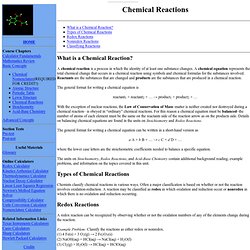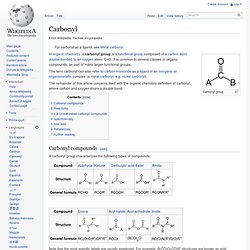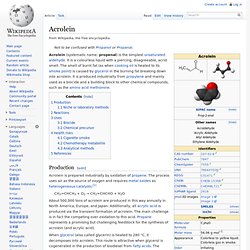

Periodic Table of Visualization Methods. 3-Visualizations & mapping. Visual Thinking. Ink - Quotes about writing by writers presented by The Fontayne Group. Writing "I put a piece of paper under my pillow, and when I could not sleep I wrote in the dark.

" Henry David Thoreau "Writing is an adventure. " Winston Churchill "Know something, sugar? Stories only happen to people who can tell them. " Allan Gurganus "... only he is an emancipated thinker who is not afraid to write foolish things. " Anton Chekhov "A poet is someone who stands outside in the rain hoping to be struck by lightening.
" "Whether or not you write well, write bravely. " 105 Writing Tips from Professional Writers. Create New Wiki. Wikidot - Free and Pro Wiki Hosting. Wikiquote.
Basic Concepts in Chemistry. Chemical Reactions. Chemical Reactions What is a Chemical Reaction?

A chemical reaction is a process in which the identity of at least one substance changes. A chemical equation represents the total chemical change that occurs in a chemical reaction using symbols and chemical formulas for the substances involved. Reactants are the substances that are changed and products are the substances that are produced in a chemical reaction. The general format for writing a chemical equation is. Functional Groups — Master Organic Chemistry. Organic Chemistry Study Tips: Reaction Maps May 7, 2012 This time of year one of the most common problems students come to me with is how to do synthesis problems.

Like this: There’s a lot of different ways to go about learning how to do synthesis – and I’ll have a lot more to say about that in future posts – but today’s post [...] Tagged as: grignard, ketones, reactions, retrosynthesis, secondary alcohols, study tips, synthesis Read the full article → Weird Nomenclature In Carbonyl Chemistry March 26, 2012. Functional group. Benzyl acetate has an ester functional group (in red), an acetyl moiety (circled with green) and a benzyloxy moiety (circled with orange).

Other divisions can be made. In organic chemistry, functional groups are specific groups of atoms or bonds within molecules that are responsible for the characteristic chemical reactions of those molecules. The same functional group will undergo the same or similar chemical reaction(s) regardless of the size of the molecule it is a part of.[1][2] However, its relative reactivity can be modified by nearby functional groups. Introduction to Oxygen Functional Groups. Oxygen Functional Groups Introduction to Oxygen Functional Groups Oxygen-containing functional groups include the alcohols, the ethers, the aldehydes, the ketones, and the carboxylic acids as well as a variety of derivatives of the carboxylic acids such as the amides, the esters, and the acid halides.

Carbonyl. Carbonyl group In organic chemistry, a carbonyl group is a functional group composed of a carbon atom double-bonded to an oxygen atom: C=O.

It is common to several classes of organic compounds, as part of many larger functional groups. The term carbonyl can also refer to carbon monoxide as a ligand in an inorganic or organometallic complex (a metal carbonyl, e.g. nickel carbonyl). The remainder of this article concerns itself with the organic chemistry definition of carbonyl, where carbon and oxygen share a double bond. Carbonyl compounds[edit] Maleic acid. Maleic acid or cis-butenedioic acid is an organic compound that is a dicarboxylic acid, a molecule with two carboxyl groups.

Its chemical formula is HO2CCHCHCO2H. Maleic acid is the cis-isomer of butenedioic acid, whereas fumaric acid is the trans-isomer. It is mainly used as a precursor to fumaric acid, and relative to its parent maleic anhydride, maleic acid has few applications. Physical properties[edit] Maleic acid is a less stable molecule than fumaric acid. Maleic acid. Acrolein. Production[edit] Acrolein is prepared industrially by oxidation of propene.

The process uses air as the source of oxygen and requires metal oxides as heterogeneous catalysts:[1] About 500,000 tons of acrolein are produced in this way annually in North America, Europe, and Japan. Additionally, all acrylic acid is produced via the transient formation of acrolein. The main challenge is in fact the competing over oxidation to this acid. When glycerol (also called glycerin) is heated to 280 °C, it decomposes into acrolein. Niche or laboratory methods[edit] Hydroxyl. Representation of an organic hydroxyl group, where R represents a hydrocarbon or other organic moiety, the red and grey spheres represent oxygen and hydrogen atoms, respectively, and the rod-like connections between these, covalentchemical bonds.

A hydroxyl is a chemical functional group containing an oxygen atom connected by a covalent bond to a hydrogen atom, a pairing that can be simply understood as a substructure of the water molecule. When it appears, it imparts to chemical structures some of its reactive and interactive properties. Halogen. History[edit] The fluorine mineral fluorospar was known as early as 1529.

Early chemists realized that fluorine compounds contain an undiscovered element, but were unable to isolate it. In 1869, George Gore, an English chemist, ran a current of electricity through hydrofluoric acid and discovered fluorine, but he was unable to prove his results at the time. In 1886, Henri Moissan, a chemist in Paris, performed electrolysis on potassium bifluoride dissolved in waterless hydrofluoric acid, and successfully produced fluorine.[1] Hydrochloric acid was known to alchemists and early chemists. Haloalkane. Tetrafluoroethane (a haloalkane) is a colorless liquid that boils well below room temperature (as seen here) and can be extracted from common canned air canisters by simply inverting them during use. The haloalkanes (also known as halogenoalkanes or alkyl halides) are a group of chemical compounds derived from alkanes containing one or more halogens.
They are a subset of the general class of halocarbons, although the distinction is not often made. Haloalkanes are widely used commercially and, consequently, are known under many chemical and commercial names. They are used as flame retardants, fire extinguishants, refrigerants, propellants, solvents, and pharmaceuticals. Subsequent to the widespread use in commerce, many halocarbons have also been shown to be serious pollutants and toxins. Organofluorine chemistry. Organofluorine chemistry describes the chemistry of organofluorine compounds, organic compounds that contain the carbon–fluorine bond. Organofluorine compounds find diverse applications ranging from oil- and water-repellents to pharmaceuticals, refrigerants and reagents in catalysis.
In addition to these applications, some organofluorine compounds are pollutants because of contributions to ozone depletion, global warming, bioaccumulation, and toxicity. The area of organofluorine chemistry often requires special techniques associated with the handling of fluorinating agents. The carbon–fluorine bond[edit] Fluorine has several distinctive differences from all other substituents encountered in organic molecules. Hydrocarbyl. Noun[edit] hydrocarbyl (plural hydrocarbyls) (organic chemistry) Any univalent radical, derived from a hydrocarbon, such as methyl or phenyl.
Ch4: Alcohols and Alkyl Halides. Benzene. Benzene is an organic chemical compound with the molecular formula C6H6. Its molecule is composed of 6 carbon atoms joined in a ring, with 1 hydrogen atom attached to each carbon atom. Because its molecules contain only carbon and hydrogen atoms, benzene is classed as a hydrocarbon. Benzyl. Phenyl group. The structure of the phenyl group attached to an "R" group. Alkyne. Alkene. Alkane. Chemical structure of methane, the simplest alkane.
Organic Chemistry Functional Groups flashcards. Periodic Table. Periodic Table.
Books I have Read. I have seen these Movies. Presidents of the US. Ted talks interesting technology. Visualizing Social Networks: A Graph Visualization Case Stud. David McCandless: The beauty of data visualization (short version) Best TED Talks. Dr. William Li's 2010 TED Talk. Daniel Pink on the surprising science of motivation. Google Image Result for. David Kelley: How to build your creative confidence. Jill Bolte Taylor's stroke of insight.
Matthieu Ricard: The habits of happiness. Matt Killingsworth: Want to be happier? Stay in the moment. John Gerzema: The post-crisis consumer. Gary Kovacs: Tracking the trackers. Steven Johnson: Where good ideas come from. Science is a Process. The 20 Best TED Talks. There’s a quote attributed to Oliver Wendell Holmes, Jr. that says the following: “The human mind, once stretched by a new idea, never regains its original dimensions.” That’s what the TED conferences do: they stretch the dimensions of your mind. Each TED speaker has 18 minutes to present an idea worth spreading in the most innovative and impactful way they can.
Speakers range from Google founders Larry Page and Sergey Brin, to a young man living in a remote village in Malawi who–at the age of 14– built a windmill for his family, from an old textbook.
Search Engines. Philosophy and Ethics. Genetic Engineering & Biotechnology News - Biotech from Bench to Business. Albatross biologists have visited this website. Committed to Advancing the Teaching of Stem Disciplines in Higher Education. Best of the Web: Hamamatsu Learning Center. The acquisition and processing of digital images is an essential aspect of biological research. While it is easy to learn how to acquire images with one’s lab microscope, that it not the same as gaining an understanding of the underlying principles of image acquisition and optimization.
Fortunately, the Hamamatsu Learning Center provides a great number of free resources designed to teach researchers basic concepts in digital imaging technology. The site contains a number of interactive Flash/Java tutorials that cover topics such as dynamic range, image processing, resolution, and analog-to-digital conversion. Additional topics such as binning and quantum efficiency are discussed in some of the many review articles found on the site.
So if you find yourself wondering about bit depth and image histograms, head on over to the Hamamatsu Learning Center to have all of your questions answered. Key: Strong Points Weak Points Ratings: Excellent Very Good Good. ApE- A plasmid Editor. Gatekeeper will report that the application is damaged and will prevent ApE from running. Molecular Movies - Home. NanoHUB.org - Simulation, Education, and Community for Nanotechnology. Resources - FEI Company. Best of the Web by Issue.
SEMCAT Quoting Software. Effective Fire Protection - Much of the United States has marginal or inadequate fire protection. Every 19 seconds, a fire department somewhere in the United States responds to a fire. According to the National Fire Protection Association (NFPA), fire departments fought almost 1.7 million fires in 2002, the latest year for which figures are available. And each year, fire kills more Americans than all natural disasters combined. The NFPA estimates that there are some 1.1 million firefighters in the United States. Those brave men and women serve valiantly every day, and all types of fire departments — career, volunteer, and combination — provide excellent public protection. Fire Protection Class ISO PPC Program.